GIGABYTE GA-J1800N-D2H Review: Dual Core Bay Trail-D at $69
by Ian Cutress on December 26, 2014 11:00 AM EST- Posted in
- Motherboards
- Intel
- Bay Trail
Direct Comparison with HP Stream 11
The two main factors in our comparative tests will be the speed, whereby the Celeron J1800 has a higher base frequency, and my extension of this, the difference in TDP. The Bay Trail-M based Celeron N2840 has a 7.5W TDP (or as Intel puts it, 4.5W SDP) compared to the 10W of the J1800. On the graphics side of the equation, both units have the HD (Bay Trail) mode equipped (4 EUs), but the J1800 also has an advantage by a vastly superior base frequency on the integrated graphics (688 MHz against 313 MHz).
Cinebench 11.5
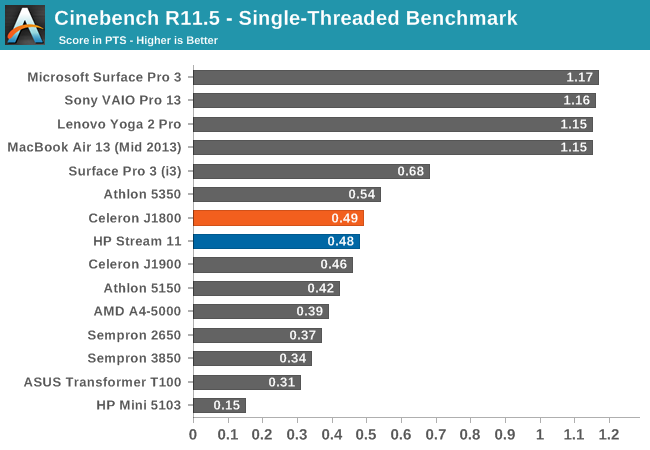
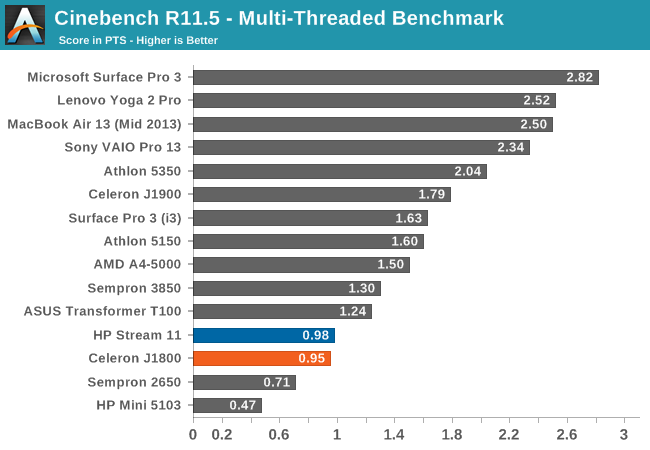
Each system trades places in Cinebench R11.5.
3DMark

The extra MHz of the J1800 puts it slightly above the Stream 11 in a synthetic video test.
Web Benchmarks
On the lower end processors, general usability is a big factor of experience, especially as we move into the HTML5 era of web browsing. For our web benchmarks on the CPUs, we take well known tests with Chrome 35 whereas the laptop results are performed in IE.
Sunspider 1.0.2
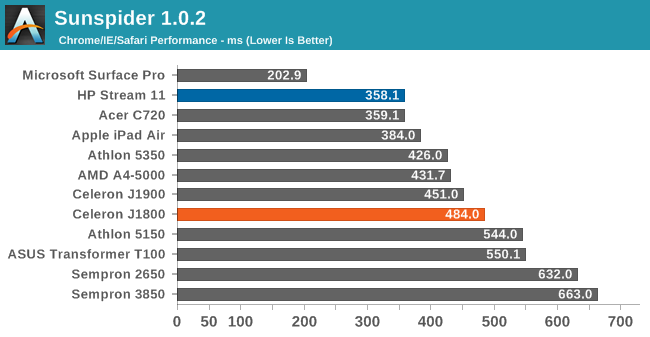
Sunspider represents a very quick CPU only test, boltered more by the software version or operating system at hand. It would seem the default settings with the HP Stream 11 make it beneficial here.
Mozilla Kraken 1.1
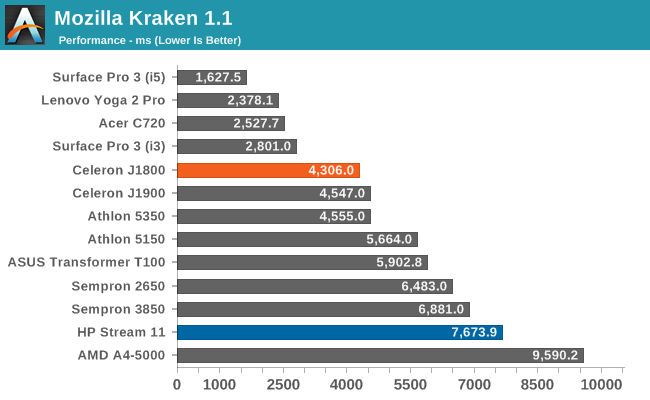
Kraken on the other hand is a bit more intense, with more memory access required. The extra memory in our desktop system most likely affected it here.
WebXPRT
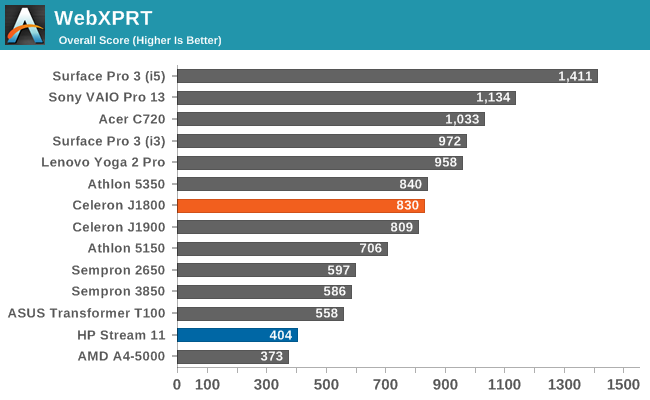
Similarly with WebXPRT, as a semi-graphical test as well, the plus side was on the Bay Trail-D desktop system.










38 Comments
View All Comments
lioncat55 - Friday, December 26, 2014 - link
When ever I see a system like this I want to build a Plex server. But it never seems like the CPU is enough.LoneWolf15 - Friday, December 26, 2014 - link
@lioncat55 - Asrock makes the Q2900-ITX , a J2900 Bay Trail quad core. You'll probably find it a little more suitable.I went Core i3-3225 at the time I built my HTPC due to the HD4000 graphics. Still working well running XBMC Gotham.
xbenny - Saturday, December 27, 2014 - link
@lioncat55 - I hear you man I'm in the same quest check out this review of Q2900-ITX @techspot http://www.techspot.com/review/882-intel-pentium-j... @LoneWolf - still not enough for on-the-fly-transcoding for Plex serverStevoLincolnite - Saturday, December 27, 2014 - link
Give it time.These chips aren't even in the same league as the Core 2 processors from 6-7 years ago in terms of performance-per-clock, but they do use a tiny fraction of the energy.
They're certainly a big step up from the old Atoms.
Might start getting competitive with Nahelem class chips in the next 3-4 years, which is when things would start to get interesting.
barleyguy - Monday, December 29, 2014 - link
You can get an AMD FX-6300 for $89, and throw it on a cheap motherboard. It works great for Plex; the 6 integer cores are surprisingly good at transcoding. I'm doing 1080p full Bluray transcoded to 20 Mbps for playback across powerline ethernet.It does use way more electricity than one of these though.
Another decent Plex server is the NVidia Jetson board. There's an accelerated Plex build for it. It's almost $200, but includes the CPU, RAM, and 16 GB of storage, so it's basically turnkey. The power usage on that is about 7 watts typical and 15 watts peak, not counting the hard drive the movies are on. (This option does require some Linux knowledge. You need to update Linux for Tegra and set up Plex server as chroot.)
$.02
KWIE - Wednesday, January 7, 2015 - link
@lioncat55 - I have a FreeNAS box with Plex Server running inside a jail on an Asrock Q1900-ITX, basically the quad core version of this, but with lower per-core frequency. There are other versions available also including one with DC-in. The above model also has 4 SATA ports (vital for me with a 4 drive ZFS setup). I boot from a Sandisk Cruzer Fit USB drive with no issues.I have one large, slow fan blowing over the drives in the entire case and never have any heat issues. Very, very happy with it... and now considering building another for a family member.
dragosmp - Friday, December 26, 2014 - link
Great review, I like the comparison with HP's Stream. To push it further I would say in this particular case it's obvious one should pick up the OEM made, but what about if someone wants a quad BT? Then for 20$ more someone can get twice the performance for 5% in system cost. It's endless reasoning, but I just wanted to point out this bitbill.rookard - Friday, December 26, 2014 - link
Agreed. I have the ASRock Q1900M (quad-core, full size DIMMs, a few more x1 slots and a full x16 (x1 wired) slot) and that allows for quite a bit more flexibility. It's still a very small board - same depth as ITX, just a little more width. The extra x1 slots could allow for some extra sata connectivity, the x16 could allow for a more powerful gpu (the intel solution onboard is marginal at best - only 4EU's).Overall though, armed with a SSD (Samsung 830) it's more than adequate for HTPC duty.
ddriver - Friday, December 26, 2014 - link
The lack of performance is otherworldly.I guess gaming benches were a logical component of the review for this product, seeing how it is definitely intended for such tasks. /sarcasm
To hell with stuff like media playback or a file server, workloads such a product is actually suited for. Who cares how this product works for stuff it is actually usable for.
Gigaplex - Friday, December 26, 2014 - link
Insufficient SATA ports for this to be used as a file server.